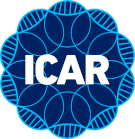Section 15 – Data Exchange
Data Exchange
Introduction
Animal Recording involves the collection, storage and exchange of data. Over time the use of electronic systems has spread from initially, in the early 1970s, being used just for centralised data processing to now (in 2016) being used in all aspects of animal recording. The electronic systems for collecting, storing, transmitting, and processing data and information have evolved to be used widely by technicians, farmers, advisors and central systems. The evolution is continuing at a rapid pace worldwide. With this spread of electronic systems the need for standards to facilitate the ready transfer of data between systems has also grown very rapidly.
This part of the ICAR guidelines (chapter 15) is devoted to standards for facilitating data transfers and to processes for ensuring electronic systems comply with the ICAR guidelines.
Goals
The goals of these guidelines are:
- To provide the developers of data processing systems with standards and processes that they can use to ensure the devices and systems they develop can be readily and reliably linked with the full range of animal data information systems used by ICAR members.
- Harmonization of the definitions of exchanged data in order to be able to exchange information between heterogeneous information systems.
- Development of global consensual data dictionaries for livestock.
- Development and installation of standardized systems to support data exchange between information systems and farm equipment.
Scope
Animal data exchange consists of:
- Business requirements and technical specifications.
- Data descriptions provided by files in compliance with the recommendations from W3C for XML schemas, UNCEFACT and ISO.
- Interface specifications provided by files in compliance with the recommendations from W3C for web service description languages (WSD).
This Guideline gives business requirements which are divided into three types:
- General business requirements which address any type of data exchange.
- Specific business requirements which address a given type of data exchange (Procedure two to five).
- Data descriptions (Appendix A).
For a given type of data exchange, specific business requirements detail the:
- purpose of data exchange;
- business context of data exchange; and
- requirements to exchange data which includes exchanged message descriptions.
Data description encompasses:
- Service description
- Message composition
- Entity description
- Data item description
- Code set description
Technical implementation deals with the implementation of the same business requirements according different ways:
- Primarily by using W3C and UNCEFACT recommendations for data and interface definition (SOAP).
- Alternatively, by using the existing ISO standards (17532:2007) for data exchange on farm with stationery equipment and REST technology (This has to be elaborated more in detail in a future version of the ICAR ADE specification).
Presentation of animal data exchange
Background
At the moment, data exchanges between equipment and external information systems do not exist or require a sort of middleware (see Figure 1) between the equipment and the information system. It is based mainly on regional, manufacturer specific or outdated international standards (ISO ADED 1996 - ISO 11788-1, ISO 11788-2 , ISO 11788-3 see here for details).

This middleware is costly to implement, difficult to maintain. It requires manual operations and does not allow to reduce the delay between an event and its registration by an external information system and to exchange large amount of data.
Equipped with modern high-speed IT infrastructure todays animal recording data centres are capable of processing huge amount of data created by an exponentially growing number of on farm equipment, sensors and analytical methods. In order to get reliable access to this data a high level of automation and standardization of data exchange has to be organized.
A data exchange in real time of a large amount of data would allow:
- animal breeding on new traits;
- improved animal monitoring by the aggregation of data from different sources: equipment, analysis laboratories etc; and
- improved farm equipment calibration in order to get more accurate measurements.
Objective of animal data Exchange
The objective is to establish direct, permanent, reliable, easy to implement and to maintain, and cost-effective exchanges of large amounts of data both ways: between equipment and external information systems and from equipment to external information systems.
How to achieve the objectives
Content of ADE
This objective may be achieved by a framework consisting of:
- an architecture to support data exchange;
- standards for messages and data;
- tools to facilitate its implementation; and
- a reactive maintenance process.
The architecture is based on a service-oriented approach where the equipment is the client of the external information system which is a service provider (see Figure 2). This architecture may be implemented by using different information technologies which are specified by this document.

- The standards encompass:
- Business requirements to use the service
- Business requirements to deliver the service
- Business requirements for exchanged data
- Semantic definition of exchange data as well as their code set
- Syntax specifications for the exchanged data according W3C, UNCEFACT and ISO
- Interface specifications according W3C, UNCEFACT and ISO
The tools to facilitate the implementation encompass:
- A web site to download:
- Files of xml data types (XSD files)
- Files of web service specifications (WSDL files)
- A test platform
ADE implementation
Figure 3 below describes the process.

